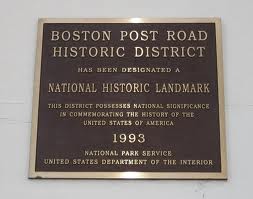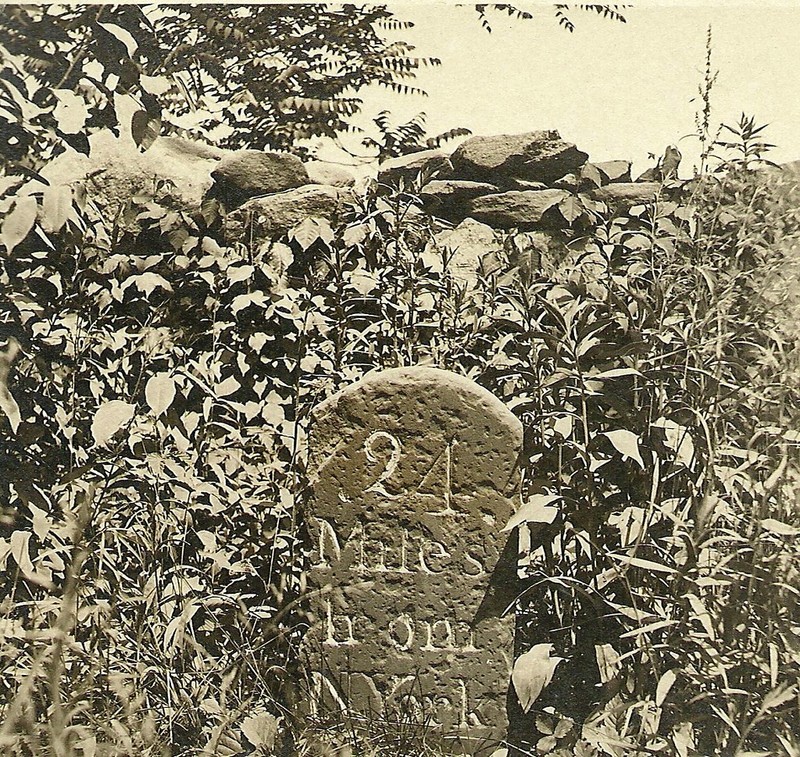This entry includes a walking tour! Take the tour.
Introduction
Text-to-speech Audio
The only National Historic Landmark District in Westchester County, the Boston Post Road Historic District includes three 19th-century mansions (Jay Heritage Center, Lounsbury and Whitby) and Marshlands Conservancy. Added to the National Register of Historic Places in 1982, it was designated a National Historic Landmark District in 1993.
Images
District Plaque, Present at Jay Heritage Center

Mile Marker 24, freestanding circa 1905, Rye, NY

Backstory and Context
Text-to-speech Audio
The site of the Boston Post Road Historic District is the only National Historic Landmark District in Westchester. It has been historically significant since 8,000 BCE when the Wisconsin glacier receded from the area and exposed three knolls that formed the Long Island Sound. The glacial recession led to Paleo-Indian activity, as evidenced by Steatite vessel fragments and Vinette I pottery found during archaeological explorations of the area.
European settlers first arrived in the Rye area in the 1600s, where they interacted with the Siwanoy people, who inhabited the land which they called Apwamis. Every autumn in the woods, the natives burnt portions of the woods to concentrate the local wildlife for hunting and foraging purpose, as the forests were flush with grapes, walnuts, chestnuts, oaks, and beech. The natives also hunted clam and oyster and left behind middens as evidence.
Hunting and gathering in Apwamis ceased on November 8th, 1661, when John Budd purchased Apwamis at the price of 80 pounds sterling from Chief Shenorock and renamed the area Budd’s Neck. In 1669, Budd died and divided the land between his sons Joseph and John. In 1672, Richard Lounsberry purchased land on Budd’s Neck. The same year, King Charles II designated the Post Road, the first on the highway on continent. The road was originally constructed five rods wide in order to provide for efficient animal driving to the markets. In 1673, the road had its first post rider couriering mail between New York and Boston, and the recipient of the mail paid the postage on it depending on the distance traveled. In 1690, Lounsberry passed to Richard Lounsberry’s wife and eldest sons. Later in 1729, his grandson Isaac would inherit the land. By 1760, Lounsberry Farms was owned by Daniel Purdy, who passed it on to his son.
Joseph Budd (son of original John Budd?), who was known as “Captain Budd,” obtained a patent for the land on Budd’s Neck in 1720. The land was inherited by his son John, who sold it on March 26th, 1745, to Peter Jay, who renamed it The Locusts. He and his family moved to the property in March of 1746 because he did wanted to protect his two children, blinded as a result of smallpox from “the dangers and confusions of the city life.” The Post Road had mile tombstone markers added in 1753 in a system devised by Ben Franklin. The 24th mile marker from New York City was placed right in front of the Jay House. Later, in 1772, the first stagecoach between New York and Boston ran along the post road.
In 1776, due to British presence in the area, the Jay family evacuated The Locusts and fled to Fishkill, NY. Peter and Mary, however, would die before they were able to return to the Locusts. Peter Jay’s son, known as Blind Peter, inherited the property in 1783 and utilized it for farming and horse breeding. That same year, George Washington toured the Post Road on his inaugural tour, stating in his diary that the condition of the road was both “pretty good” and “very bad”.
The 19th Century would bring the most change to the Boston Post Road Historic District. After Blind Peter’s death in 1813, John Jay inherited the property and had his eldest son administer it. Two years later in 1815, John Jay established the Jay Cemetery, which is the oldest functioning private cemetery in New York State. On September 16th, 1822, John Jay conveyed the property to Peter Augustus Jay; John would later die seven years later in 1829. In 1838, Peter Jay built the Greek Revival house that exists on the property today. The new home was renamed Alansten. In 1843, Peter Augustus Jay died and conveyed the property to Dr. John Clarkson Jay. In 1891, John Clarkson Jay died, with his family electing to rent out the Jay House until they later sold it in 1904 for $300,000.
In 1831, Edward Lamb Parsons purchased the neighboring Lounsberry Farms for a sum of $5,500. In 1836 Parsons enlarged an existing house into a high style Greek Revival home. A year after completion, Edward died suddenly on his return from a business trip in England. Lounsbury has remained in the Parsons family almost without interruption to the present day.
In 1854, Whitby was built by William Chapman in a Gothic Revival design made by the notable architect Alexander Jackson Davis. Chapman held the property until the 1870s when it was sold to Joseph Park, the co-founder of Park & Tilford Grocers. In 1920, Whitby was sold, and the house was incorporated into the private Rye Country Club. In 1965, Rye Country Club and Whitby were acquired by the City of Rye and converted into a public golf course which is still in use today.
After purchasing the Jay estate in 1906, Warner Van Norden added a Carriage House and a barn for zebras on the property. He also imported rare Grevey Zebras. He sold Jay Estate in 1911 to Edgar Palmer who conveyed the estate to his daughter, Zilph Devereux. In 1966 and 1967, Zilph Devereux donated the Jay Estate and 23 acres of land around it to the United Methodist Church on the condition that they are not to be developed. She gave an additional 120 acres to Westchester County for conservation efforts, which is now the Marshlands Conservancy. The remaining 14 acres of her land was sold to developers, which turned into 22 residencies. In 1973 the fate of the Jay Estate was in question when Diane Millstein’s development company acquired it and sparked an effort to save the estate from redevelopment. This effort resulted in The Boston Post Road Historic District being listed in the National Register of Historic Places in 1982. Despite this, Millstein’s development company purchased Jay Estate for $1.075 million in 1983. After many negotiations, Westchester County purchased the Jay Property for $11.5 million in 1992, creating the Jay Heritage Center which included the Jay House, the Carriage House, and one and a half acres of land.
In 1987, Fanny Parsons donated Lounsberry to the city of Rye on her death, but the city was unable to find a non-profit willing to manage the property, so they sold it David Parsons the grandson of Edward Parsons. In 1993, the Boston Post Road Historic District designation was elevated to a National Historic Landmark, which is given to the most important historic sites in the United States.
This entry was revised by Dylan Pirone on Sept. 30th, 2021
Sources
Jay Heritage Center. “Chronology: The Boston Post Road Historic District.” Rye: New York, n.d.
National Register of Historic Places. Boston Post Road Historic District, September 1982.
Accessed September 22nd 2021. https://catalog.archives.gov/id/75316110.
Jay Heritage Center. Lounsberry/The Parsons Estate (C). Boston Post Road Historic District Brochure.
Lavin, Lucianne. Birgit, F. Morse. CERAMIC ASSEMBLAGES FROM THE RYE MARSHLAND AREA OF SOUTHERN NEW YORK .
The Bulletin and Journal for Archaeology of New York State, no. 91 13 - 26. Published Fall 1985. NYS Archaeology.
Accessed September 22nd, 2021. https://nysarchaeology.org/download/nysaa/bulletin/number_091.pdf
Jay Heritage Center, photo credits Minard38
Jay Heritage Center
